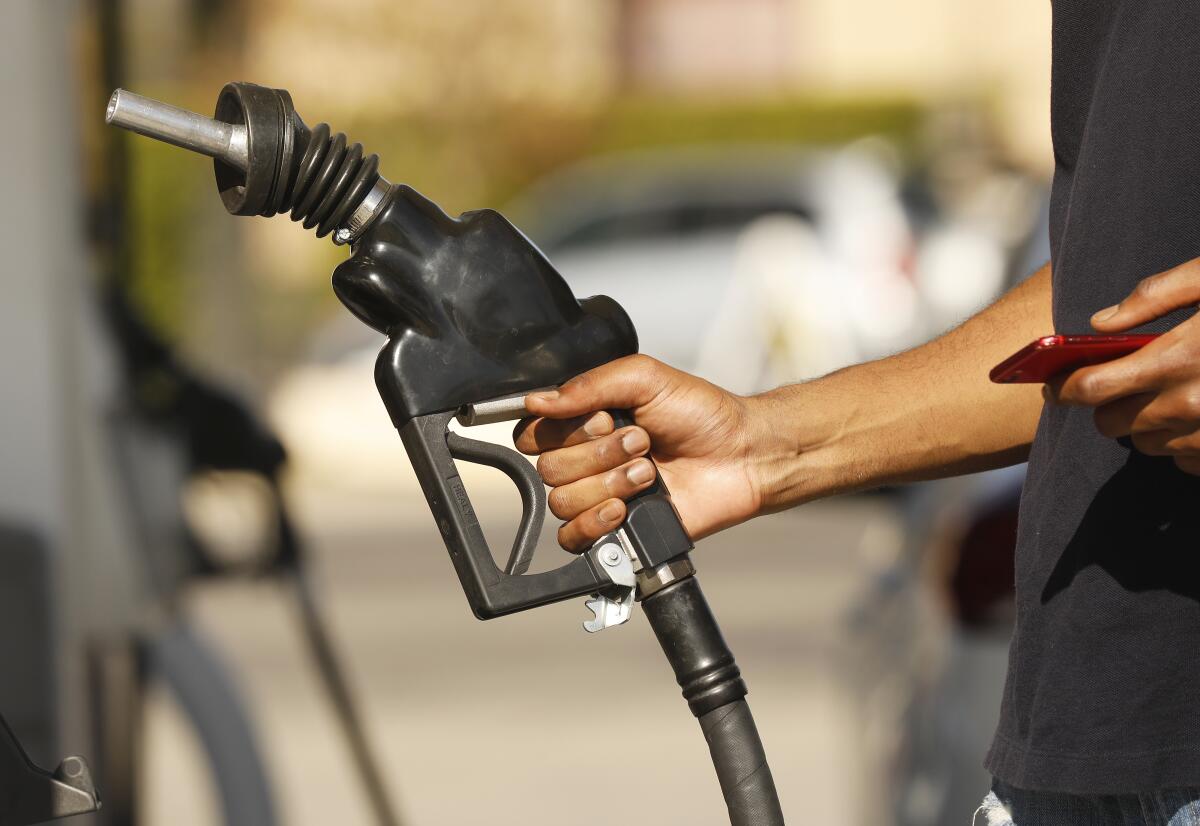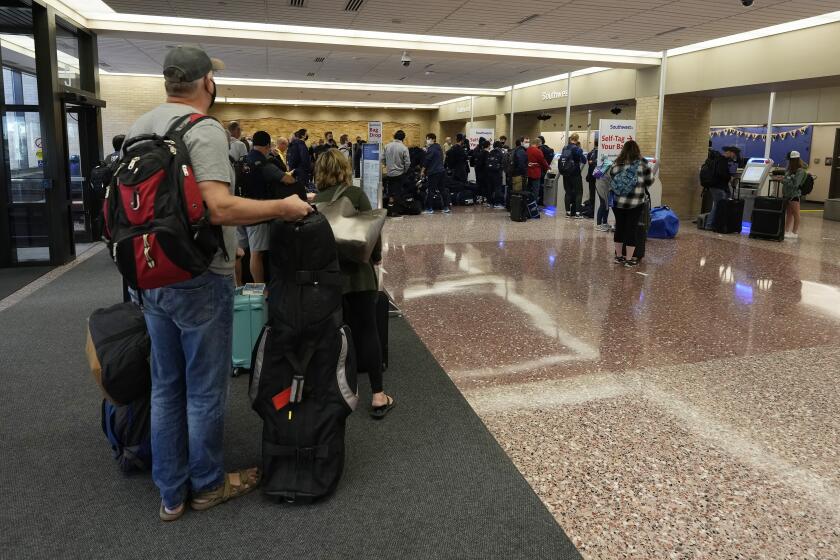Los Angeles gas prices are falling fast. But how long can it last?

- Share via
Southern California drivers are getting more relief at the gas pump, with the average cost of a gallon of regular gas in Los Angeles County slipping below $5.50.
Gas prices have fallen from recent record highs nationwide because oil prices and gasoline demand have declined and gasoline supplies have increased, analysts said. But oil and gasoline prices are volatile creatures, and market watchers are mixed about when gas prices might drop below $5 a gallon in the state.
A gallon of regular gasoline cost $5.48 on average Monday in L.A. County, down nearly a dollar since peaking June 14 at $6.46, according to the American Automobile Assn. That’s the lowest price since March 7.
L.A. County’s average price put it at the No. 10 spot among 31 California markets tracked by AAA. The San Luis Obispo area was the most expensive at $5.80 a gallon; El Centro was the cheapest at $5.15 a gallon.
California’s prices remain the highest in the nation, with a statewide average at $5.45, well above the national average of $4.06, AAA data show.
GasBuddy.com oil analyst Patrick De Haan predicts that per-gallon gas costs are likely to drop below $5 in L.A. County and statewide, barring unforeseen disruptions or significant changes in supply and demand.
Beverly Hills Car Club and co-owner Alex Manos have built a following, but lawsuits accuse the dealership of selling vehicles with undisclosed damage, defective parts or other issues.
The main drivers for decreasing gas prices, De Haan said, include a slowing economy, which could limit oil consumption, and declining crude oil prices helped by traders anticipating the possible return of Iranian oil to the global market as the U.S. and Iran move closer to negotiations on reviving Iran’s 2015 nuclear deal.
“There’s been a lot of flare-ups and geopolitical tensions that could weigh on markets at some point,” De Haan said.
“For now, we have pretty good odds that L.A. will get under the $5 mark, but it will take time,” De Haan said.
Gas below $5 can be found in L.A., with the two lowest prices on East 3rd Street at Berri Brothers ($4.59) and Arco ($4.65) in East Los Angeles, according to GasBuddy.
Doug Shupe, communications manager for AAA, is more uncertain about if and when Californians could see $5 gasoline become widely available.
“We don’t know what we’re gonna see here in Southern California,” Shupe said. “We’re hopefully going to see more relief at the pump for drivers.... We just don’t know how long that trend will continue.”
Shupe said one factor affecting the pump would be holiday travel as people gear up for the Labor Day holiday in early September.
The U.S. Department of Transportation proposed rule changes Wednesday to make it easier for airline passengers to collect refunds for canceled or delayed flights.
“People are still prioritizing their budgets to take their family road trips this summer,” Shupe said. “And that’s what we saw both over Memorial Day and for the Fourth of July. And it’s also what we’re expecting to see for the Labor Day holiday as well.”
AAA recently released a survey that found 64% of U.S. adults have changed their driving habits since March in response to high gas prices. The top three changes are driving less, combining errands and reducing shopping or dining out.
However, De Haan said he believes drivers are not changing their habits significantly enough to affect gasoline’s price.
Gas consumption is only 5% to 8% below the usual level for this time of year, and although that has increased the supply slightly, it isn’t near the levels predicted, De Haan said.
“That we’re seeing prices go down has nothing to do with a very small decrease in demand,” he said.
The price of crude oil is the most significant component of gasoline costs, representing 60% of the price per gallon, the U.S. Energy Information Administration estimated. And this component continues to remain high.
While millions are paying hefty prices at the pump, oil and natural gas companies are raking in the profits. Last month, the five largest oil and natural gas companies reported a combined $55 billion in second-quarter profits.
De Haan said the ongoing conflict between Russia and Ukraine, alongside the pandemic, is still a factor in the high prices.
“Now, as the economy ramps back up, very little is able to keep pace with the rebound,” including oil production, De Haan said. “So we’re not going to get back to normal until we completely normalize in a post-COVID world and until the war in Ukraine is over.”
After the crisis in Ukraine began Feb. 25, the price of crude oil steadily hovered above $90 a barrel, reaching a height of more than $120. On Thursday, the price fell below the $90 mark for the first time since February.
More to Read
Inside the business of entertainment
The Wide Shot brings you news, analysis and insights on everything from streaming wars to production — and what it all means for the future.
You may occasionally receive promotional content from the Los Angeles Times.













